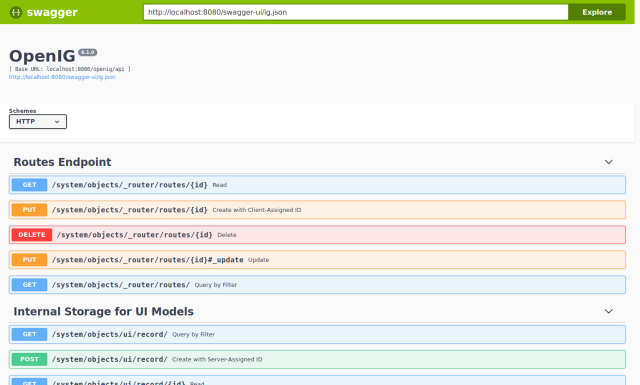 This post briefly describes the types of HTTP APIs available through the ForgeRock platform, and which ones come with live reference documentation.
This post briefly describes the types of HTTP APIs available through the ForgeRock platform, and which ones come with live reference documentation.
The following categories of HTTP APIs are available in the ForgeRock platform:
ForgeRock Common REST (CREST) APIs
ForgeRock Common REST provides a framework for HTTP APIs. Each of the component products in the platform uses CREST to build APIs that do CRUDPAQ operations in the same ways.
ForgeRock platform component products generate live reference documentation in a standard format (Swagger, which has been standardized as OpenAPI) for CREST APIs. This is done through a mechanism referred to as API descriptors. You can use this documentation to try out the CREST APIs.
Standard HTTP APIs such as OAuth 2.0
Standard HTTP APIs are defined by organizations like the IETF for OAuth 2.0, the Kantara Initiative for UMA, and the OpenID Connect Working Group. These APIs have their own implementations and do not use CREST. They are documented where they are used in the product documentation.
The canonical documentation is the specifications for the standards. At present, the ForgeRock platform components do not generate live documentation for these standard APIs.
Non-RESTful, Challenge-Response HTTP APIs
Some APIs, such as the authentication API used in ForgeRock AM and the user self-service API used in ForgeRock IDM are not fully RESTful. Instead, they use challenge-response mechanisms that have the developer return to the same endpoint with different payloads during a session.
These APIs are documented in the product documentation.
The ForgeRock API reference documentation published with the product docs is, necessarily, abstract. It does not provide you a sandbox to try out the APIs. Unlike a SaaS, with its fixed configuration, the ForgeRock platform components are highly configurable. ForgeRock HTTP APIs depend on how you decide to configure each service.
Live Reference Documentation
It is your software deployment or SaaS, built with the ForgeRock platform, that publishes concrete APIs.
You can capture the OpenAPI-format docs, and edit them to correspond to the APIs you actually want to publish. A browser-based, third-party application, Swagger UI, makes it easy to set up a front end to a sandbox service so your developers can try out your APIs.
Note that you still need to protect the endpoints. In particular, prevent developers from using the endpoints you do not want to publish.
The following posts in this series will look at how to work with the APIs when developing your configuration, and how to get the OpenAPI-format descriptors to publish live API documentation for your developers.
 This post is part of a series about how to get live reference documentation for ForgeRock REST APIs.
This post is part of a series about how to get live reference documentation for ForgeRock REST APIs.

